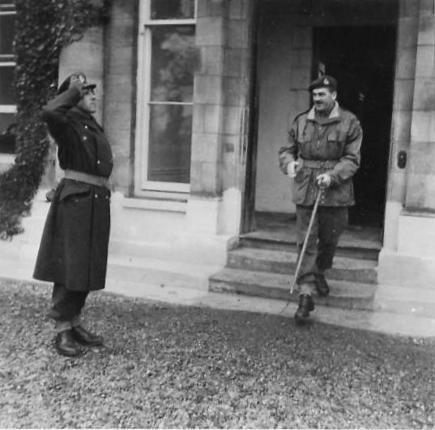Fulbeck Hall

Major General Urquhart leaves Fulbeck Hall in December 1944, to the smart salute of a member of the 1st Airborne Division Provost Company, Corps of Military Police. (IWM H40945)
Fulbeck was at the heart of the British 1st Airborne Division’s 1944 activity and planning for the largest ever wartime air assault – Operation MARKET GARDEN.
Under the command of Major General Robert 'Roy' Urquhart, the Division's Headquarters was accommodated in Fulbeck Hall, with headquarters elements of the Royal Electrical and Mechanical Engineers and the Royal Army Ordnance Corps in nearby Fulbeck Manor. The Pegasus winged horse insignia of the British Airborne Forces became a familiar sight throughout the village.
Coordinated from its Fulbeck headquarters, Divisional training was relentless, including mock village invasions, practice parachute drops and gruelling fitness marches. The Church of St Nicholas welcomed officers and men to its regular services, and the shattered ranks of 1st Airborne Division re-grouped to once again worship in the Church after they had returned from the Netherlands.
To discover more about Fulbeck Hall's wartime history, visit the Paradata website here: Fulbeck Hall.
PLEASE NOTE: FULBECK HALL IS A PRIVATE RESIDENCE AND IS NOT OPEN TO THE PUBLIC. PLEASE RESPECT THE OWNERS' PRIVACY.
(We are very grateful to the owners of Fulbeck Hall for allowing us to take photographs of the Hall and its historical artefacts for publication.)
The remains of a room allocation list can still be seen on the wall of the former Intelligence Office. (Dr Tim Clack)
A depiction of a civilian hat with the Flemish word for ‘demobilization’: graffiti left on the wall of the former Intelligence Office by members of the Independent Belgian Brigade while waiting for their demobilization at the end of the war in 1945.
The Brigade - commonly known as the Piron Brigade (Brigade Piron) after its commanding officer Jean-Baptiste Piron - was a Belgian and Luxembourgish military unit in the Free Belgian forces during World War II. It saw action in Western Europe and participated in the battle of Normandy, the liberation of Belgium, and fighting in the Netherlands over 1944-1945. (Brian Riley)
Some of the members of the Piron Brigade sleeping in this room appear to have adopted nicknames based on Sleeping Beauty’s Seven Dwarves. This bed-space was occupied by ‘Dopey’. (Brian Riley)
This bed-space was apparently occupied by a champion boxer. (Brian Riley)
This bed-space was occupied by ‘Sleepy’. Apparently, someone in the Piron Brigade also liked Leamington, where part of the Brigade had been based!
‘België Vrij’ - ‘Free Belgium’ – said it all for the men of the Piron Brigade. (Brian Riley)
A ‘List of Honour’ which shows the names of places where the Brigade had been based. The top of the list is ‘Leamington’. (Brian Riley)
A chalked sign ‘G1098 Store’ on a door in the cellar of Fulbeck Hall. In the British Army, the G1098 Form was a schedule of equipment required to support the official Unit Establishment. Some items, notably instruments, wireless sets and watches, were 'controlled stores' and issue of replacements had to be authorised by the General Staff. (Brian Riley)
A chalked sign on a door in the cellar of Fulbeck Hall, indicating that this room had been used as an ammunition store.
- ‘SAA’ stands for ‘Small Arms and Ammunition’, which are weapons and ammunition designed for individual use, such as revolvers and self-loading pistols, rifles and carbines, sub-machine guns, assault rifles, and light machine guns.
- The marking ‘75mm’ could refer to 75mm artillery ammunition used by the 1st Airborne Division’s light artillery howitzers.
- It is not known what the marking ‘2 Be’ means.
- The drawing on the right could be of ‘Chad’, a popular wartime cartoon figure used in a humorous way to draw attention to various shortages, often accompanied by a caption, such as ‘Wot, no meat?’ There may have been a caption here at one time, or the marking may have simply been a doodle to pass time. (Brian Riley)